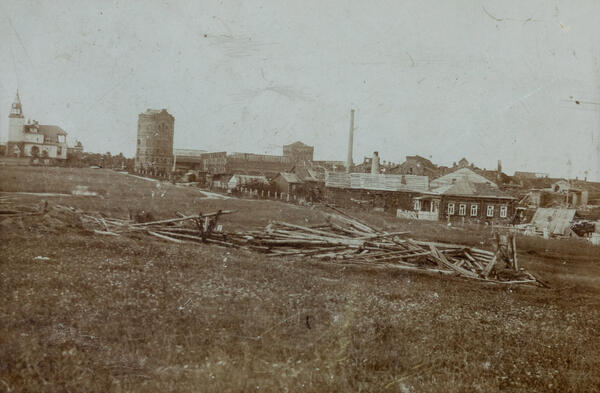The hurricane that ripped through the region in June 1904 left a significant imprint on Mytishchi. Many buildings, including the Mytishchi Railcar-Building Plant, were damaged. And the Sharapovo village was the one that suffered major devastation. The hurricane came from Moscow, which took its brunt. The journalist Vladimir Gilyarovsky who witnesses this event gave his description of the disaster that happened in Moscow in the Russkoye Slovo (literally: Russian Word) newspaper:
Photograph of the Sharapovo Village
Creation period
early 20th century
Place of сreation
Russia
Dimensions
28,4x36 cm
28.4×36 cm
28.4×36 cm
Technique
paper, cardboard, photo printing
Collection
Exhibition
5
Open in app#5
Unknown Author
Photograph of the Sharapovo Village
#2
#6
‘The sky turned yellow, large hail came after the drizzle, the cloud grew dark and touched the tops of bell towers. Everything was tinted an ominous yellow that replaced the darkness. The storm broke and it became cold. A black cloud descended on Sokolniki. Below it was growing while another one was lowering itself on top of it. Suddenly, everything began to whirl. Lightnings were flashing inside that swirling dark mass. Yellow lights flared amidst darts of lightning, and a crimson and yellow pillar of fire was spinning in the middle of it all. A moment later, this horror rushed past destroying everything in its way. It carried roofs, planks, rang bells, tore out crosses and domes, rooted away trees—centuries-old trees were slivered or toppled. Iron roofs were torn off, rolled like sheets of paper, carried along the streets. Bodies here and there. So many dead and wounded… The hurricane rushed to Yaroslavl, leaving a trace of destruction for hundreds of kilometers…’
#7
The hurricane left traces in our region, too. In Mytishchi and its vicinity, trees were uprooted, forming heaps in the forests of the Moose Island. Forge pipes at the Mytishchi Railcar-Building Plant snapped like matches, freight cars ready for departure were scattered across the territory of the factory, roofs were torn off of all shops together with frameworks. The speedy winds and twisters lifted wagons off the ground and threw them hundred of meters away. A lot of cattle died.
In the nearby Yadreevo and Rupasovo, the wind tore roofs off several houses, destroyed barns, and threw haystacks about. Only the sturdiest buildings on the outskirts of Sharapovo, near the railroad station, survived, including the house of the car-building factory’s director and houses of the workers of the Mytishchi station. To celebrate the miraculous rescue of Sharapovo, the village headman Prokuronov funded the painting of the icon of Tikhon Amafuntovsky that was placed in the main side chapel of the Vladimir Church in Bolshie Mytishchi. Every year on June 16, the village arranged a cross procession and took this icon to every house.
In the nearby Yadreevo and Rupasovo, the wind tore roofs off several houses, destroyed barns, and threw haystacks about. Only the sturdiest buildings on the outskirts of Sharapovo, near the railroad station, survived, including the house of the car-building factory’s director and houses of the workers of the Mytishchi station. To celebrate the miraculous rescue of Sharapovo, the village headman Prokuronov funded the painting of the icon of Tikhon Amafuntovsky that was placed in the main side chapel of the Vladimir Church in Bolshie Mytishchi. Every year on June 16, the village arranged a cross procession and took this icon to every house.
#8
Municipal Budget Cultural Institution “Mytishchi History and Art Museum”
read morehide
00:00
00:00
1x
Photograph of the Sharapovo Village
Creation period
early 20th century
Place of сreation
Russia
Dimensions
28,4x36 cm
28.4×36 cm
28.4×36 cm
Technique
paper, cardboard, photo printing
Collection
Exhibition
5
Open in app
Share



